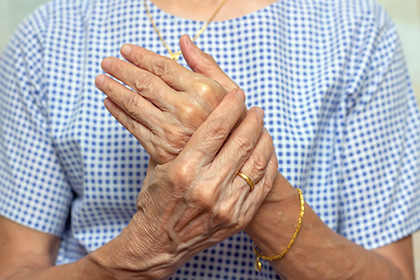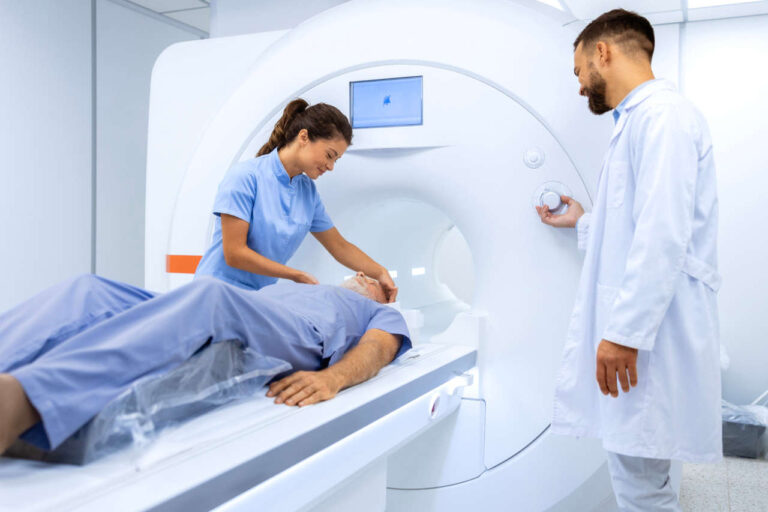
Introduction
Neuropathy is a general term referring to the condition that results from damage or dysfunction of one or more nerves. It is often called “peripheral neuropathy” because symptoms commonly manifest as numbness, weakness, tingling, and/or sometimes pain, which usually starts in the hands and feet. However, neuropathy can affect any part of the body where there is nerve damage.
The human nervous system is composed of two major parts: the central nervous system (CNS) and the peripheral nervous system (PNS). The CNS consists of the brain and the spinal cord, while the PNS refers to the remaining, complex nerve network that spreads throughout the body. There are 12 pairs of cranial nerves and 31 pairs of spinal nerves that connect the CNS and the PNS. Any disease or condition that compromises this connection will lead to neuropathy.
Get IVIG Copay Assistance
Speak to a SpecialistNerve damage can occur in a variety of ways. Some develop it from a direct injury such as stab wounds, motor vehicle accidents, falls, and even postural defects. More commonly, others develop it from chronic wear secondary to uncontrolled diabetes, vitamin deficiencies, chronic inflammations, and autoimmune diseases.
Regardless of the cause, living with neuropathy can be very daunting. There are many treatment options available that can significantly relieve its symptoms and improve everyday quality of life.
Types of Neuropathies

Neuropathies can be further classified into specific types based on the following factors:
1. The Number of Nerves Affected:
- Mononeuropathy: Only one nerve is involved. Bell’s palsy is a type of mononeuropathy in which the facial nerve is damaged.
- Polyneuropathy: Multiple nerve cells are affected, usually in different parts of the body. Diabetic neuropathy is the most common type of polyneuropathy.
- Mononeuritis Multiplex: Two or more separate single nerves are involved, usually in different areas of the body.
2. The Types of Nerves Affected:
- Sensory Neuropathy: Involves sensory nerve fibers in one or more nerves. It results in sensory symptoms such as tingling, paresthesia, numbness, etc.
- Motor Neuropathy: Involves motor nerve fibers. It results in weakness and, in severe cases, muscle paralysis.
- Autonomic Neuropathy: Involves autonomic nerve fibers. It affects autonomic functions, resulting in poor blood pressure control, poor bladder control, glandular dysfunction, etc.
3. How the Nerves Are Affected:
- Neuritis: Inflammation of nerve fibers caused by an immune response, chemical intoxication, viral infection, or radiation exposure.
- Compression Neuropathy: Results from compression of one or more nerves, usually associated with skeletal structural malformation and/or damage. Carpal tunnel syndrome is a common form of compression neuropathy, which results from compression of the median nerve in the wrist.
Symptoms
Symptoms of neuropathy vary depending on the type of the disease as well as the underlying cause.
Sensory Symptoms
When sensory fibers of a nerve are affected in the disease process, patients may experience symptoms such as:
- Tingling or “pins and needles” sensation
- Sharp or burning pain, especially in the extremities
- Numbness
- Decreased sensitivity to pain or temperature
- Loss of balance
Motor Symptoms
When motor fibers of peripheral nerves are affected, patients may experience the following symptoms:
- Muscle spasms
- Muscle cramps
- Twitching
- Muscle weakness or paralysis
- Loss of power
Autonomic Symptoms
When nerves regulating the body’s autonomic functions are affected, patients may experience irregular or even loss of basic body functions. Some of the more common manifestations include:
- Either constipation or diarrhea as a result of altered gastric motility
- Urinary incontinence due to dysfunction of autonomic nerves around the bladder
- Arrhythmia and/or blood pressure fluctuations due to improper autonomic responses in the circulatory system
- Sweating disorders; may lead to excessive sweating or no sweating at all
- Sexual dysfunction (e.g., erectile dysfunction in men)
Consult an IVIG Specialist
The Best IVIG Home Infusion | Get IVIG Treatment AssistanceCauses

Causes of neuropathy may be genetic, acquired, or idiopathic.
Genetic
Some neuropathic diseases, such as hereditary neuropathy with liability to pressure palsy (HNPP), are inherited, meaning that the genes that cause the conditions are passed down from a parent. In patients with HNPP, there is a mutation or deletion of a gene that results in loss of myelin. Myelin is a protective layer that covers and insulates the axons of nerve cells, which plays a critical role in ensuring proper response to appropriate stimuli. When it is compromised, however, conductions become unstable. As a result, symptoms associated with this condition vary from patient to patient. Some experience significantly increased sensitivity to pressure, while others experience weakness and decreased reflexes.
Acquired
Most neuropathies are acquired, usually as a result of either direct injury to the nerves or wear from an underlying systemic condition.
1. Physical Causes
- Injury to Nerves: Any trauma to the nerves caused by sports injuries, stab wounds, automobile accidents, electrical shocks, etc., often leads to neuropathy.
- Compression: Structural abnormalities caused by skeletal deformities (scoliosis, carpal tunnel syndrome, etc.) or tumors may lead to nerve compression. In such cases, pain and/or weakness results from having the nerve conduction “pinched” off.
- Surgical Complication: Neuropathy may develop as a complication of some surgical procedures. For example, a research study found that LASIK surgeries can cause corneal neuropathy in 20% to 55% of patients.
2. Secondary Causes
- Diabetic Neuropathy: Chronic, uncontrolled diabetes may often lead to nerve damage. In such patients, excess glucose in the body accumulates in and around the nerves. Over time, this begins to not only interrupt the conduction of nerve impulses but also cause the structural breakdown of myelin, resulting in neuropathy.
- Autoimmune: Some patients develop neuropathy as a result of their own immune system mistakenly attacking their nerves. This results in neuritis and, if left untreated, even degeneration of nerves. Such a reaction is usually triggered after a stimulus such as a chemical injury, physical trauma, radiation exposure, or viral infection (e.g., herpes zoster). Guillain-Barre Syndrome, chronic inflammatory demyelinating polyneuropathy (CIDP), and postherpetic neuralgia are some well known conditions that fall into this category.
- Drug Reaction: Neuropathy may occur due to adverse reactions of some drugs. For example, antibiotics within the fluoroquinolone class (ciprofloxacin, levofloxacin, moxifloxacin, etc.) are known to cause this, especially with frequent or prolonged use. A study suggests that these drugs can sometimes even cause irreversible neuropathy in some patients.
- Vitamin Deficiency: Neuropathies may arise as a result of deficiencies of essential vitamins such as vitamin B1 (thiamine), vitamin B12 (methylcobalamin), vitamin A, and vitamin E. Vitamin B12 deficiency is one of the most common causes of neuropathy. Methylcobalamin is needed for the synthesis and repair of the myelin sheath, and having a lack of this vitamin results in degeneration of myelin sheath.
Idiopathic
In some rare cases, neuropathies may arise without any clear cause. In such cases, treatment is focused on symptomatic relief. Further tests may be done to determine how the nerves are affected for better management.
Consult an IVIG Specialist
The Best IVIG Home Infusion | Get IVIG Treatment AssistanceDiagnosis
Because signs and symptoms of neuropathy tend to be general, identifying the root cause is essential for proper treatment and management. The diagnosis of various types of neuropathy depends on the following factors:
- History
- Physical Examination
- Laboratory Investigations
History
The complete history of when and how the neuropathy symptoms developed is critical in establishing an appropriate diagnosis. Consider the following questions:
- What unusual symptoms are present?
- When did they first start?
- How did the symptoms develop over time?
- What happened prior to the onset of symptoms?
- What makes them worse?
The more information that the doctor has, the easier it will be to see the full picture. It is very important to be as transparent and detailed as possible. Make sure to review all prior diagnoses and/or surgical procedures with the doctor as well to see if there are any connections. Also, review any current medications that are being taken, even herbal supplements.
Physical Examination
In conjunction with the patient’s medical history, the doctor may perform various physical examinations to learn more about the presenting condition. Depending on the doctor’s suspicion, these may include, but are not limited to, the following:
- Checking the patient’s reflexes, muscle tone, balance, coordination, and muscle strength to evaluate the patient’s motor system.
- Checking the patient’s ability to feel various sensations such as heat, cold, pain, light, touch, etc., to evaluate the patient’s sensory nervous system.
- Checking the patient’s sphincter tone, heart rate, blood pressure, and respiration upon applying various stimuli to evaluate the patient’s autonomic system.
After a thorough evaluation, the doctor will be able to reach a provisional diagnosis, which will then need to be further investigated through laboratory tests.
Laboratory Investigations
These are usually the final steps before the doctor establishes a definite diagnosis. Various laboratory tests are done to not only confirm his or her suspicions but also to determine the optimal plan for treatment. Three types of tests that are generally performed are:
- Blood Labs
- Imaging studies
- Electrodiagnostic studies
Blood labs
Blood laboratory analyses are done to check for any underlying conditions contributing to neuropathy. The doctor generally looks for any imbalances or deficiencies of electrolytes, hormones, blood glucose level, and/or antibody levels. The following are some of the more common tests done for neuropathy:
- Fasting blood glucose: To check for underlying diabetes
- Erythrocyte sedimentation rate (ESR) and C-reactive protein (CRP) levels: To check for the presence of any inflammation
- Complete blood count: To rule out any hematological causes
- Serum electrolytes: To check for electrolyte imbalances
- Liver function tests: To assess liver function
- Vitamin B12 and folate: To look for any deficiencies or excesses
- Antinuclear Antibody (ANA) profile: To detect presence of any unusual or excess of antibodies
Imaging studies
A radiograph of the skull, chest, or spine may be performed to detect any structural defects that may be contributing to neuropathy.
Magnetic resonance imaging(MRI) may be performed on the suspected regions to look for any nerve compression, entrapment, or injury. Tumors may also be found through an MRI.
Electrodiagnostic studies
Nerve conduction studies are performed to assess nerve function. Using electrodes, a small amount of current is passed through the nerve, which is then measured at the other end. The amount of electrical stimulus measured can then be used to assess the nerve response.
Electromyography is similar to nerve conduction tests, except that it assesses the connections of nerves to their corresponding muscle.
Further Investigations
Additional tests may be done case by case to further identify the root cause of neuropathy, especially when it appears to be idiopathic.
- Genetic testing: To find if there are any genetic or hereditary links
- Serum Amyloid: To rule out amyloidosis
Consult an IVIG Specialist
The Best IVIG Home Infusion | Get IVIG Treatment AssistanceTreatment Options
Treatment is dependent on the diagnosis. For example, diabetic neuropathy is usually managed by improving blood glucose control and oral relief medications, while Guillain-Barre Syndrome may involve periodic intravenous infusions. In all cases, the treatment approach is centered around symptomatic relief and preventing disease progression.
Analgesics
For patients with neuropathy, traditional analgesics such as ibuprofen, Tylenol, or even opioids will provide minimal relief. Tramadol, a schedule 4 controlled substance, is the only one in this class of drugs that has successfully relieved neuropathic pain. Even then, it is usually reserved for breakthrough relief when other treatments have failed to achieve the desired response.
Anticonvulsant Drugs
Like neuropathy, seizures are also associated with inappropriate and unstable neural conductions. Therefore, anticonvulsants such as pregabalin (Lyrica) and gabapentin (Neurontin) have been widely used to relieve neuropathic pain. These are often prescribed as first-line treatments for neuropathy, and many patients maintain very well on one of these drugs without further treatment.
Topical Treatment
Certain topical creams are also used to relieve neuropathic pain. These are often used for mild, intermittent neuropathy or as an adjunct to systemic treatments because they are limited to providing local relief. The most commonly used creams are lidocaine and capsaicin, which are available over-the-counter.
Lidocaine is an anesthetic that relieves pain by temporarily blocking nerve conductions of the site where it is applied.
Capsaicin is a chemical found in hot peppers. It is the component that causes the “spicy” or “burning” sensation. Applying this cream to the site of neuropathy can relieve pain by numbing the pain receptors in the area. If used, be sure to thoroughly wash hands immediately after applying to avoid getting it to other undesired areas (especially the eyes).
Plasma Exchange Therapy
Plasma exchange therapy is an option for autoimmune neuropathy. It helps remove the harmful antibodies causing inflammation and/or destruction of nerves, providing relief over time. It has been proven effective in axonal neuropathy and demyelinating polyneuropathy.
Physiotherapy
Patients who have been battling neuropathic pain for a long time may have lost some muscle mass due to lack of movement. Physiotherapy is a supportive therapy considered once neuropathy has somewhat resolved. It involves various types of exercises that help to regain muscle coordination and power.
Intravenous Immune Globulin (IVIG) Therapy
For patients with autoimmune neuropathy such as Guillain-Barré syndrome (GBS), chronic inflammatory demyelinating neuropathy (CIDP), and multifocal motor neuropathy (MMN), intravenous immune globulin infusions may not only significantly relieve their symptoms but also treat the underlying cause. Although the actual mechanism of action is unclear, IVIG therapy has proven benefits for neuropathy within this category.
Immune globulins are a type of antibody that is present in the blood. They are produced by the immune system mainly to help fight off infections. When present in high amounts, they have been shown to neutralize harmful autoantibodies and prevent the production of any new ones. This effect not only stops the disease progression but also allows the nerves to recover from the damage. Over time, many patients on this treatment even regain muscle strength, balance, and coordination.
IVIG infusions for neuropathy are usually given as a cycle of up to 5 separate days of infusions once every month. Each one usually lasts about 3-5 hours, depending on the dose and history of tolerance. They are safely done at home as long as a trained infusion nurse can be arranged for direct administration and supervision. Common side effects include headache, nausea, and flu-like symptoms, but they are generally mild and do not last more than a few days. Pre-medications such as Tylenol (acetaminophen) and Benadryl (diphenhydramine) are often given to help reduce the frequency and severity of these reactions.












